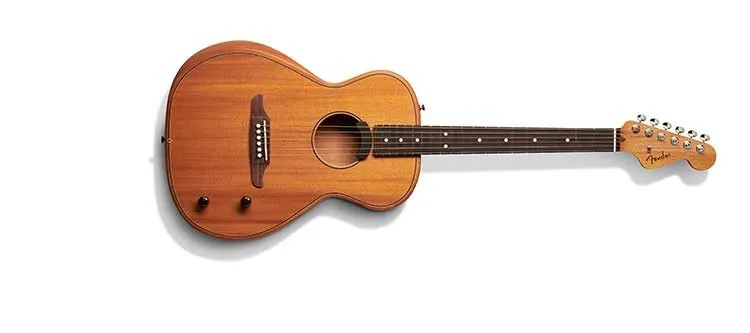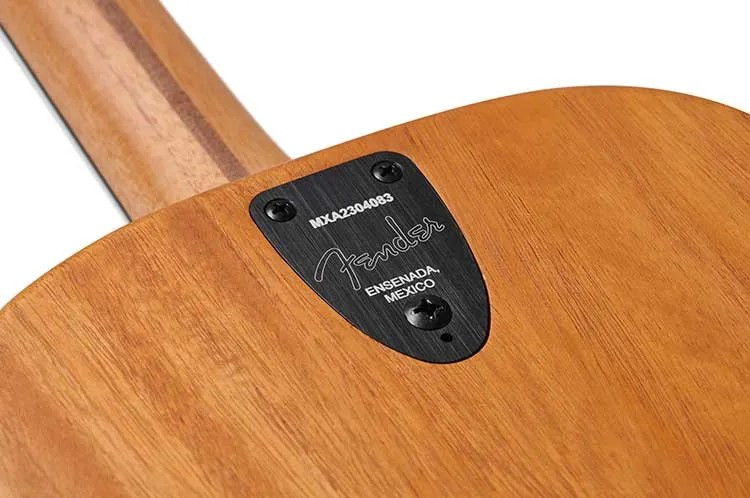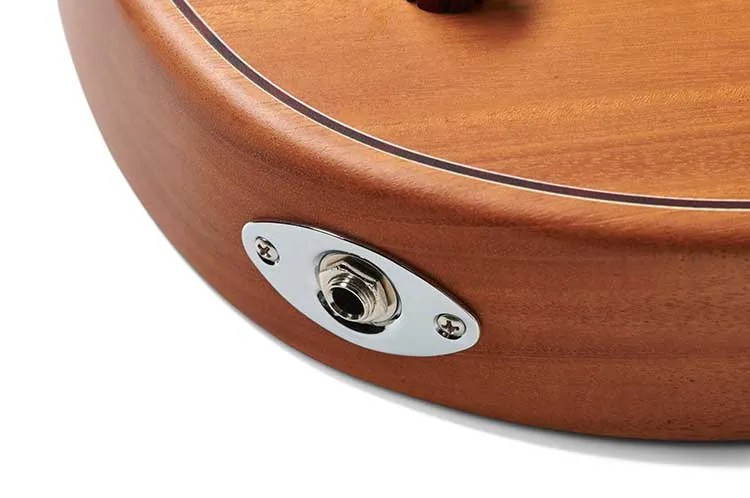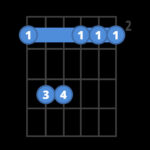When you’ve spent years immersed in the world of guitars, testing countless instruments, it’s natural to approach a familiar design with pre-conceived notions. My initial thoughts on the new Fender Highway Series Parlor were undoubtedly shaped by the lens of “thin body acoustic made by a company known for electric guitars.” Would it truly bridge the gap and offer something unique for players seeking a versatile instrument?
Many of my initial assumptions weren’t entirely off-base. The neck, while featuring a shorter scale, felt immediately familiar to anyone accustomed to a Telecaster. The headstock, with its signature six-in-line tuners, is unmistakably Fender. And the sleek, comfortable contours echo the design ethos that has defined Fender since the dawn of the Stratocaster over seven decades ago. These are all hallmarks of Fender’s electric guitar legacy translated into an acoustic format.
However, what truly surprised me was the sheer fullness of sound emanating from this remarkably compact and lightweight instrument. The tone was round, even, and surprisingly robust. It delivered a low-end presence that belied its diminutive size, while projecting sound effectively enough for unplugged playing in intimate settings. This was an acoustic voice that defied expectations, proving that thin-body acoustics could indeed possess depth and resonance.
Yet, it’s clear that the Highway, equipped with its custom-designed Fishman Fluence pickup, is engineered to truly shine when amplified. My testing involved various scenarios: through a Phil Jones Nano Bass X4 amp, direct into my Universal Audio Apollo interface, and of course, unplugged. Across all these configurations, I was consistently impressed by the guitar’s exceptional tone and sonic versatility. This isn’t just an acoustic guitar with a pickup; it’s an acoustic-electric instrument meticulously crafted for amplified performance.
 Fender Highway Series Parlor acoustic-electric guitar
Fender Highway Series Parlor acoustic-electric guitar
Exploring the Sonic Landscape
The Highway Parlor represents the smaller sibling in Fender’s line of thin-bodied acoustic-electric guitars. It’s available in two distinct variations: an all-mahogany construction, or a spruce top paired with mahogany back and sides. (My evaluation focused on the all-mahogany model.) Importantly, the Highway diverges from previous attempts to create acoustic versions of Fender’s iconic electric guitars. Instead, it’s thoughtfully designed for players who appreciate the traditional acoustic silhouette but desire a more streamlined and less bulky body. The Highway’s aesthetic is undeniably modern and sleek, almost aerodynamic in its curves, making it visually inviting and ergonomically appealing.
However, much of the guitar’s innovation lies beneath the surface. The body is chambered, incorporating a tapered floating X-bracing pattern. This sophisticated internal architecture is key to producing a rich, full sound characterized by a rounder, less harsh high-end and a substantial, rather than scooped, midrange. This bracing design allows the thin body to resonate in a way that maximizes tonal output and complexity, defying the limitations often associated with thinner acoustic guitars.
The Highway’s construction blends acoustic tradition with Fender’s electric guitar DNA. The neck attachment utilizes a three-bolt system, complete with a tilt adjustment for fine-tuning the neck angle – a design reminiscent of vintage Fender electrics, such as the 1980 Stratocaster. However, modern manufacturing precision and tighter tolerances elevate this design far beyond its vintage counterparts. The neck joint is exceptionally stable, eliminating dead spots and ensuring consistent resonance across the fretboard.
Initially, the action on the test guitar was a touch high for my preference. Thankfully, adjustments were straightforward using the included Allen wrenches for both the truss rod and neck angle. While a detailed manual wasn’t included with the review model, the adjustments proved intuitive and quick, taking just minutes to achieve a highly playable setup. This ease of adjustability is crucial for players who value personalized setup and optimal playing comfort.
The neck profile is Fender’s familiar “C” shape, coupled with a comfortable 12-inch fretboard radius. The nut width is slightly narrower at 1.6875 inches, and the frets are tall and narrow, evoking a vintage Fender feel. The overall playing experience on the Highway is undeniably enjoyable. Despite the neck’s electric-like feel, I found myself naturally drawn to fingerstyle acoustic techniques during testing. The fretboard offers ample space for chord shapes and allows open strings to ring clearly in arpeggiated patterns. Conversely, I observed a student who typically struggles with barre chords on standard acoustics find the Highway significantly easier to play, highlighting its accessibility for players of varying hand sizes and experience levels.
Fender emphasizes the thin body design as enhancing player comfort. While I personally don’t find traditional acoustic guitars uncomfortable, the reduced depth and contoured shape of the Highway offer a different ergonomic experience. For players who find larger-bodied acoustics cumbersome, or those accustomed to the ergonomics of electric guitars, the Highway presents a comfortable and familiar alternative. Its ease of handling makes the Highway a guitar that’s easy to live with, even for players who are comfortable with larger instruments.
 Fender Highway Series Parlor back
Fender Highway Series Parlor back
Innovative Electronics: The Fishman Fluence Pickup
A defining feature of the Highway is its active Fishman Fluence pickup system, which distinguishes itself both visually and sonically from conventional acoustic-electric setups. The transducer, mounted discreetly at the top of the soundhole, boasts a crescent shape that elegantly mirrors the soundhole’s curvature. Its organic aesthetic, with the black pickup providing a subtle contrast to the mahogany’s warm finish, is visually appealing. The guitar’s back panel houses a dedicated battery compartment for the Fluence’s 9-volt power source, as well as an access panel for servicing the electronics, ensuring easy maintenance and battery changes.
Positioned below the bridge on the guitar’s lower bout are two control knobs: volume and contour. The contour control is a departure from typical tone controls, offering a spectrum of sonic profiles rather than a simple treble cut. In the fully clockwise position, the tone becomes richer and more “jazzy,” while in the counter-clockwise extreme, it leans towards a brighter, more purely acoustic character. The range between these extremes is vast, providing a wealth of tonal shades to explore. This innovative control allows players to sculpt their amplified tone to suit a variety of musical styles and performance contexts.
Through the Phil Jones Nano Bass amp – a compact amplifier renowned for its substantial low-end response – the Highway exhibited a deep and resonant character. In my standard review process, I typically begin by simply playing, allowing the instrument to guide my exploration before systematically evaluating specific aspects. The Highway naturally led me to fingerstyle playing, emphasizing melodies on the lower strings. The guitar responded beautifully, offering precise control over attack and a clear, powerful tone. A slight treble boost on the amp further enhanced the articulation of the higher strings, resulting in an impressively balanced amplified tone across all six strings. The Fluence pickup avoids the harshness often associated with piezo systems, delivering a smooth and natural amplified acoustic sound.
Plugging directly into the Universal Audio Apollo interface and monitoring through headphones provided a more isolated listening environment, allowing for a detailed assessment of the contour control’s functionality. My perception is that the high-end frequencies remain largely unaffected, while the midrange and low-midrange frequencies are dynamically shaped by the contour knob. In the fully clockwise position, the low-end becomes punchier and more pronounced, whereas the counter-clockwise setting yields a tighter, more controlled bass response. The ability to precisely tailor the midrange, particularly emphasizing the lower mids, would be exceptionally useful for optimizing the guitar’s sound when feeding directly into a house PA system in live performance settings.
 Fender Highway Series Parlor output jack
Fender Highway Series Parlor output jack
The Highway to Versatility
Fender’s vision for the Highway is clear: to offer an alternative to traditional acoustic instruments, retaining the essence of a flattop’s shape and sonic character while incorporating features appealing to electric guitarists. The fast, comfortable neck and the thin, manageable body are undoubtedly tailored to electric players venturing into the acoustic realm. In this regard, the Highway hits its target squarely. It successfully bridges the gap between electric and acoustic worlds, offering a familiar playing experience for electric guitarists while delivering a genuine acoustic voice.
Will the Highway resonate with traditional acoustic players? It’s worth acknowledging that for seasoned acoustic players comfortable with dreadnoughts or nylon-string guitars, the thinner neck profile might not be revolutionary. However, the Highway’s broad tonal range, coupled with the dynamic interaction of its resonant body, sets it apart from both typical electric guitars and conventional acoustics. I envision the Highway as a compelling option for musicians exploring looping and effects-driven acoustic music, where the organic tone of an acoustic instrument is desired, but the control and playability of an electric guitar are paramount. The Fender Highway Series Parlor carves its own path, offering a unique and versatile voice in the landscape of acoustic-electric guitars.

